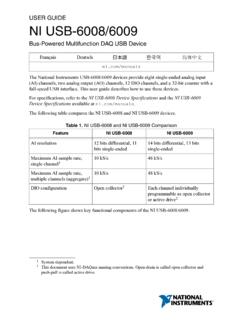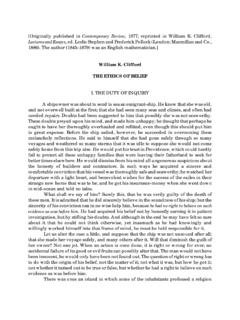Transcription of 6Entropy & the Boltzmann Law - Brandeis University
1 6 Entropy &. the Boltzmann Law S = k log W. What Is Entropy? Carved on the tombstone of Ludwig Boltzmann in the Zentralfriedhof (central cemetery) in Vienna is the inscription S = k log W . ( ). This equation is the historical foundation of statistical mechanics. It connects the microscopic and macroscopic worlds. It de nes the entropy S, a macro- scopic quantity, in terms of the multiplicity W of the microscopic degrees of freedom of a system. For thermodynamics, k = 10 23 J K 1 is a quantity called Boltzmann 's constant, and Boltzmann 's inscription refers to the natural logarithm, loge = ln. In Chapters 2 and 3 we used simple models to illustrate that the composition of coin ips, the expansion of gases, the tendency of particles to mix, rubber elasticity, and heat ow can be predicted by the principle that systems tend toward their states of maximum multiplicity W . However, states that maximize W will also maximize W 2 or 15W 3 +5 or k ln W , where k is any positive constant.
2 Any monotonic function of W will have a maximum where W has a maximum. In particular, states that maximize W also maximize the entropy, S = k ln W . Why does this quantity deserve special attention as a prediction principle, and why should it have this particular mathematical form? In this chapter, we use a few general principles to show why the entropy must have this mathematical form. But rst we switch our view of entropy from 81. a multiplicity perspective to a probability perspective that is more general. In the probability perspective, the entropy is given as S t = pi ln pi . ( ). k i=1. Let's see how Equation ( ) is related to Equation ( ). Roll a t-sided die N. times. The multiplicity of outcomes is given by Equation ( ) (see page 12), N! W = , n1 !n2 ! .. nt ! where ni is the number of times that side i appears face up. Use Stirling's approximation x! (x/e)x (page 56), and de ne the probabilities pi = ni /N, to convert Equation ( ) to (N/e)N.
3 W =. (n1 /e)n1 (n2 /e)n2 .. (nt /e)nt NN 1. = n1 n2 nt = n1 n2 n . ( ). n1 n2 .. nt p1 p2 .. pt t Take the logarithm and divide by N to get t 1 t SN. ln W = ni ln pi ln W = pi ln pi = , ( ). i=1. N i=1. Nk where SN indicates that this is the entropy for N trials, and the entropy per trial is S = SN /N. For this dice problem and the counting problems in Chap- ters 2 and 3, the two expressions for the entropy, Equations ( ) and ( ), are equivalent. The attest distributions are those having maximum multiplicity W in the absence of constraints. For example, in N coin ips, the multiplicity W = N!/[(nH !)(N nH )!] is maximized when nH /N nT /N , that is, when the probabilities of heads and tails are as nearly equal as possible. There are di erent types of entropy, depending on the degrees of freedom of the system. Examples and describe translational freedom due to the di erent positions of particles in space.
4 In the next example we apply Equation ( ) to the rotational or orientational entropy of dipoles. We show that atter probability distributions have higher entropy than more peaked distributions. EXAMPLE Dipoles tend to orient randomly. Objects with distinguish- able heads and tails such as magnets, chemically asymmetrical molecules, elec- trical dipoles with (+) charges at one end and ( ) charges at the other, or even pencils with erasers at one end have rotational freedom as well as translational freedom. They can orient. Spin a pencil on a table N times. Each time it stops, the pencil points in one of four possible directions: toward the quadrant facing north (n), east (e), south (s), or west (w). Count the number of times that the pencil points in each direction; label those numbers nn , ne , ns , and nw . Spinning a pencil and counting orientations is analogous to rolling a die with four sides labeled n, e, s or w.
5 Each roll of that die determines the orientation of one pencil or 82 Chapter 6. Entropy & the Boltzmann Law (a) Ordered (b) Biased (c) Biased (d) Random pi 1. 1 1. 2 2 1 1 1 1 1 1. 3 1 1 3. 6 6 4 4 4 4. 0 0 0 0 0. n e s w n e s w n e s w n e s w Figure Spin a hundred pencils. Here are four (of a large number) of possible distributions of outcomes. (a) All pencils could point north (n). This is the most ordered distribution, S/k = 1 ln 1 = 0. (b) Half the pencils could point east (e) and half could point south (s). This distribution has more entropy than (a), S/k = 2(1/2 ln 1/2) = (c) One-third of the pencils could point n, and one-third w, one-sixth e, and one-sixth s. This distribution has even more entropy, S/k = 2(1/3 ln 1/3 + 1/6 ln 1/6) = (d) One-quarter of the pencils could point in each of the four possible directions. This is the distribution with highest entropy, S/k = 4(1/4 ln 1/4) = dipole.
6 N die rolls correspond to the orientations of N dipoles. The number of con gurations for systems with N trials, distributed with any set of out- t comes {n1 , n2 , .. , nt }, where N = i=1 ni , is given by the multiplicity Equa- tion ( ): W (n1 , n2 , .. , nt ) = N!/(n1 !n2 ! nt !). The number of di erent con gurations of the system with a given composition nn , ne , ns , and nw is N! W (N, nn , ne , ns , nw ) = . nn !ne !ns !nw ! The probabilities that a pencil points in each of the four directions are nn ne ns nw p(n) = , p(e) = , p(s) = , and p(w) = . N N N N. Figure shows some possible distributions of outcomes. Each distribution function satis es the constraint that p(n) + p(e) + p(s) + p(w) = 1. You can compute the entropy per spin of the pencil of any of these distributions t by using Equation ( ), S/k = i=1 pi ln pi . The absolute entropy is never negative, that is S 0.
7 Flat distributions have high entropy. Peaked distributions have low entropy. When all pencils point in the same direction, the system is perfectly ordered and has the lowest possible entropy, S = 0. Entropy does not depend on being able to order the categories along an x-axis. For pencil orientations, there is no di erence between the x-axis sequence news and esnw. To be in a state of low entropy, it does not matter which direction the pencils point in, just that they all point the same way. The attest possible distribution has the highest possible entropy, which increases with the number of possible outcomes. In Figure we have four states: the attest distribution has S/k = 4(1/4) ln(1/4) =. ln 4 = In general, when there are t states, the at distribution has entropy S/k = ln t. Flatness in a distribution corresponds to disorder in a system. What Is Entropy? 83. p The concept of entropy is broader than statistical thermodynamics.
8 It is a property of any distribution function, as the next example shows. 3 3 EXAMPLE Colors of socks. Suppose that on a given day, you sample 30. 10 10 students and nd the distribution of the colors of the socks they are wearing 2. 10 (Figure ). The entropy of this distribution is 1 1. 10 10 S/k = ln ln ln = For this example and Example , k should not be Boltzmann 's constant. Boltz- mann's constant is appropriate only when you need to put entropy into units w g bl r br that interconvert with energy, for thermodynamics and molecular science. For Color other types of probability distributions, k is chosen to suit the purposes at Figure The entropy can hand, so k = 1 would be simplest here. The entropy function just reports the be computed for any relative atness of a distribution function. The limiting cases are the most or- distribution function, even dered, S = 0 (everybody wears the same color socks) and the most disordered, for colors of socks: white S/k = ln t = ln 5 = (all ve sock colors are equally likely).
9 (w), green (g), black (bl), red (r ), and brown (br ). Why should the entropy have the form of either Equation ( ) or Equation ( )? Here is a simple justi cation. A deeper argument is given in Optional Material,' page 89. The Simple Justi cation for S = k ln W. Consider a thermodynamic system having two subsystems, A and B, with multi- plicities WA and WB respectively. The multiplicity of the total system will be the product Wtotal = WA WB . Thermodynamics requires that entropies be extensive, meaning that the system entropy is the sum of subsystem entropies, Stotal =. SA + SB . The logarithm function satis es this requirement. If SA = k ln WA and SB = k ln WB , then Stotal = k ln Wtotal = k ln WA WB = k ln WA + k ln WB = SA + SB . This argument illustrates why S should be a logarithmic function of W .. Let's use S/k = i pi ln pi to derive the exponential distribution law, called the Boltzmann distribution law, that is at the center of statistical thermo- dynamics.
10 The Boltzmann distribution law describes the energy distributions of atoms and molecules. Underdetermined Distributions In the rest of this chapter, we illustrate the principles that we need by concoct- ing a class of problems involving die rolls and coin ips instead of molecules. How would you know if a die is biased? You could roll it N times and count the numbers of 1's, 2's, , 6's. If the probability distribution were perfectly at, the die would not be biased. You could use the same test for the orientations of pencils or to determine whether atoms or molecules have biased spatial orien- tations or bond angle distributions. However the options available to molecules are usually so numerous that you could not possibly measure each one. In sta- tistical mechanics you seldom have the luxury of knowing the full distribution, corresponding to all six numbers pi for i = 1, 2, 3.





![LINEAR ALGEBRA MIDTERM [EXAM A] - Brandeis University](/cache/preview/2/a/5/a/8/6/f/b/thumb-2a5a86fbead498bbe4749596c75df645.jpg)









![XiTkjNlm`k]gR TknWopR crq lms tHu R vwTkXiq](/cache/preview/0/6/0/4/3/b/0/9/thumb-06043b09a92afe85fe6fb5ea35baaecc.jpg)